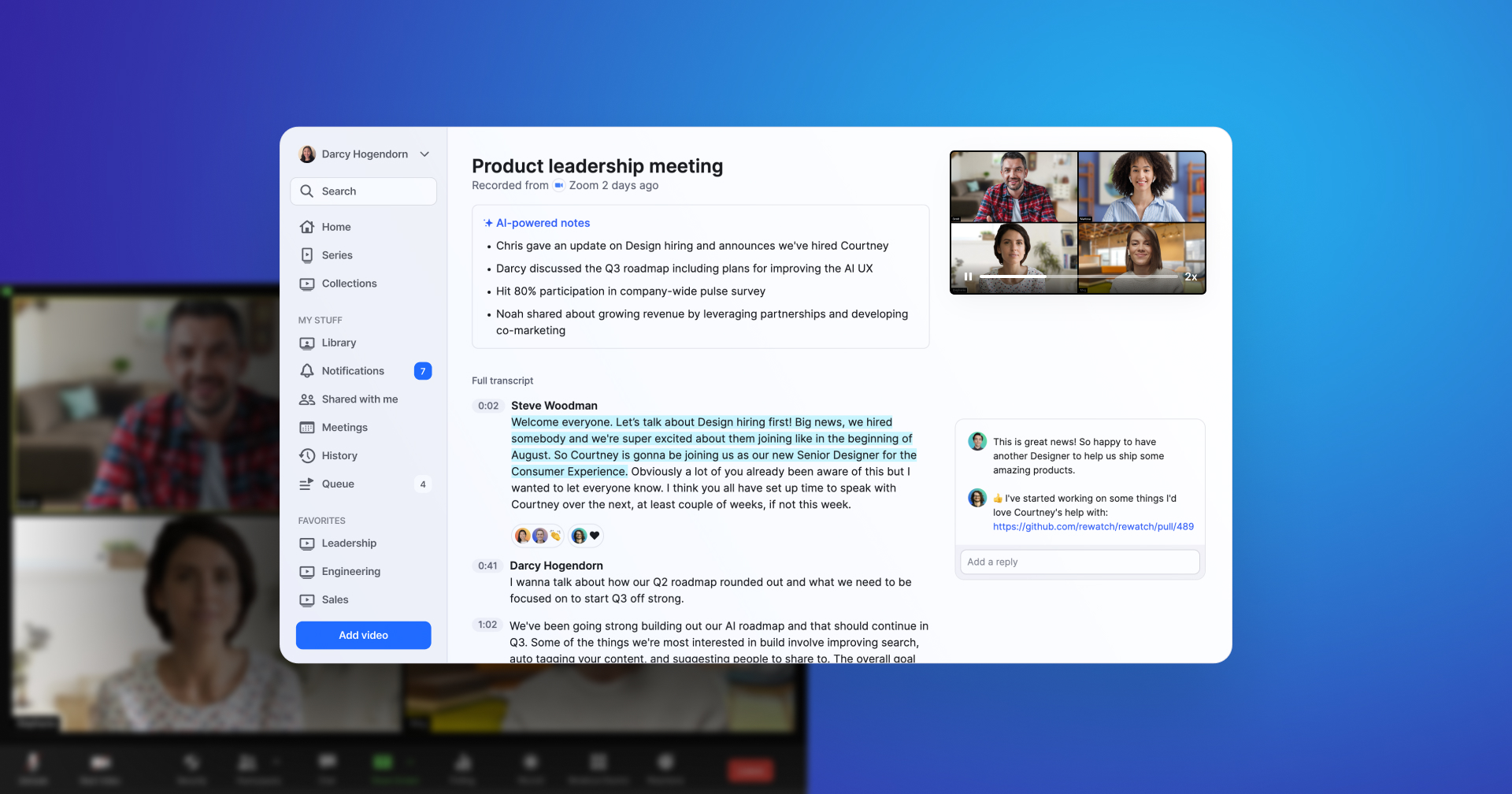Step-by-step guide for transcribing meeting minutes
Transcribing meeting minutes can be a tough manual task. Here’s how to automatically transcribe meeting minutes in 4 quick steps.
By Darcy Hogendorn in

Step-by-step guide for transcribing meeting minutes
We’re all familiar with the “meeting that should have been an email,” and in the post-pandemic shift to remote and hybrid work environments, these exhausting meetings have surged: Research shows that people now spend twice as much time in meetings and receive 50% more work chat messages, leading to overwork, burnout, and fatigue. With more time spent in meetings than ever, teams need a way to organize the information that comes out of them to make the most out of everyone’s time.
Video meeting transcription is one excellent way to do this. Transcribing meeting minutes with subtitles ensures that everyone is on the same page. Meeting transcriptions create a text version of everything said during your meeting, making it easy for team members to refer back to whether they were present for the real-time meeting or not. When team members have the flexibility to circle back to a meeting when it’s convenient for them (rather than drop everything to attend in the moment), they can work more productively — and experience less fatigue in the process.
We’ve compiled this handy step-by-step guide for transcribing meeting notes. We’ve also rounded up a list of best practices for meetings to support clean transcriptions — and identified one top-notch resource that will help you reap the many benefits of transcribing your meeting minutes.
1) Record the meeting on a trustworthy platform
The first step in maximizing your meetings with transcription is to record the meeting using a trustworthy digital platform.
One of the benefits of recording meetings is that it allows participants to watch (or review) in their own time.
However, it also serves another purpose: Relying on a team member to take minutes in real time comes with many potential issues, such as missing key points and action items or misinterpreting and misrelating essential information. In some cases, it’s simply impossible to keep up with the speed of the discussion as it’s happening.
Recording your meetings opens the door to automating the transcription process. Sure, you could screen record your meetings or even use your phone to record the audio. However, do you really want to be worried about remembering to hit the record button or whether the audio will pick up every word?
That’s where video transcription services come in.
2) Select a video transcription service
Some organizations task employees with transcribing minutes of meetings from video recordings or a recording file. This can be a waste of human capital and can even compromise employee satisfaction when you consider the drudgery involved with note-taking.
Today’s sophisticated AI-powered video transcription services mitigate this issue while also increasing speed and accuracy. Review the options available on the market and determine which offer the features your team needs. Do you need multilingual transcriptions, or one language only? Are you using Zoom, Google Meet, or other video conferencing software that needs to integrate with your transcription software?
3) Automatically transcribe your meeting minutes using a tool
Going with a video transcription service that automates meeting note-taking adds yet another level of efficiency by eliminating the extra step of opting into transcription.
Once you select your transcription software, turn it on and let it run during your next meeting. The software should automatically pick up each speaker, creating verbatim meeting minutes — no manual note-taking required. (Tip: You may want to run a test meeting or two with your new software to work out any kinks ahead of a real meeting.)
Signing up for a video transcription tool like Rewatch puts this technology at your fingertips for video meetings, video conferencing, video calls, and more. Find out how Rewatch can streamline your transcription process and optimize your meetings like never before.
4) Review and share your transcription with your team
More than half of office professionals spend more time looking for online files than they do working.
Do you really want to spend time pointing people to the shared folders and hoping they’ll find the right meeting notes when they can automatically receive the information they need?
In addition to boosting productivity by automatically sharing transcribed videos, some automatic transcription services also offer powerful insights into who is watching transcribed videos. This can help you ensure that everyone has access to meeting minutes and makes the most of the access.
How long does it take to transcribe 15 minutes?
The amount of time it takes for a human to transcribe audio varies depending on many factors, including the playback quality, speaker speed, and the transcriptionist's experience.
Manual transcription is extremely time-consuming. According to one industry standard, a single hour of audio can take an average of four hours to transcribe.
That means a 15-minute meeting will take approximately one hour to transcribe! And that’s assuming you’ve got an on-demand transcriptionist ready and able to drop everything, transcribe your video, proof it, and send it to the appropriate parties. Otherwise, you’re looking at a wait of anywhere from 24 hours to a week to receive your complete full transcript. This is just too long in today’s fast-moving business landscape where decisions need to be made quickly.
With powerful transcription tools like automated transcription services and transcription software, the entire process happens in a mere fraction of that time — and with extremely high accuracy.
Meeting best practices for a clean transcription
Of course, your meeting transcription is only as good as the meeting recording. In fact, research indicates that certain factors, such as excellent audio quality and a limited number of speakers, can dramatically improve transcription.
The good news is that there are some things you can do during your meetings to ensure a good quality audio recording and support the best transcription results, including adopting these best practices:
- Use a meeting agenda template.
- Enlist a moderator to direct and guide the discussion.
- Talk slowly and pause between speakers.
- Ask speakers to identify themselves whenever they speak.
- Ask attendees to mute themselves when not speaking.
- Avoid using filler words (ums, uhs, etc.) whenever possible.
- Select a quiet conference room or other controlled setting whenever possible.
- Invest in a high-quality meeting transcription tool or service.
While not everyone in your meetings will adhere to each of these best practices, if the majority of the speakers do, you’ll enjoy better results and make it easier for team members to follow up on missed meetings.
Transcribe your meetings with Rewatch
We’ve highlighted the importance of transcribing meeting minutes, and defined best practices for running meetings to optimize the quality of your audio file and transcription. We also highlighted the value of selecting a high-quality audio transcription service that offers useful features and functionalities, such as automation, AI technology, API integration, customization, and more.
Enter Rewatch. An innovative hub designed to help organizations securely save, manage, and search all your video content, Rewatch offers high-quality automated and accurate transcription services for organizations looking to make the most of their meetings.
Book a demo of Rewatch today to experience the power of high-quality automated meeting transcription.
Insights for the modern workplace
Get fresh ideas and practical tips to help your team work better, together. Delivered straight to your inbox.

